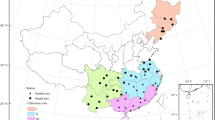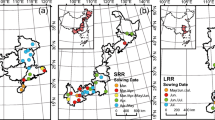Abstract
Rice phenology was determined by temperature and agronomic management. It was essential to quantify the interaction between warming temperatures and rice phenology to understand the impact of climate change in rice farming systems. Based on the quantitative analysis of data from double-cropping rice in the south of China in the last 20 years, we found that the average temperature of the whole growth periods of early rice and late rice increased by an average of 0.76 °C and 0.49 °C decade−1, respectively. The whole growth period (WGP) change trend of early rice decreased by 0.07 d decade−1, but the WGP of late rice increased 1.26 d decade−1. The vegetative growth period (VGP) and the reproductive growth period (RGP) of early rice and late rice were all shorted. Regression analysis showed that the VGP of early rice and late rice decreased by 2.99 days and 2.82 days, and the RGP decreased by 1.67 days and 1.81 days, respectively, as the mean air temperature increased by 1 °C during the corresponding stages. The WGPs of early rice and late rice decreased by 3.81 days and 5.31 days, respectively, with the mean air temperature increased by 1 °C during growth duration. According to our studies, the rising mean air temperature could lead to a shortening of the double-rice growth period. Therefore, we must adjust the planting pattern of the double-rice system to mitigate and adapt to future climate change.






Similar content being viewed by others
Abbreviations
- VGP:
-
Vegetative growth period
- RGP:
-
Reproductive growth period
- WGP:
-
Whole growth period
References
Abbas, G., Ahmad, S., Ahmad, A., Nasim, W., Fatima, Z., Hussain, S., et al. (2017). Quantification the impacts of climate change and crop management on phenology of maize-based cropping system in Punjab, Pakistan. Agricultural and Forest Meteorology, 247, 42–55. https://doi.org/10.1016/j.agrformet.2017.07.012.
Bi, L. D., Zhang, B., Liu, G. R., Li, Z. Z., Liu, Y. E. A. R., Ye, C., et al. (2009). Long-term effects of organic amendments on the rice yields for double rice cropping systems in subtropical China. Agriculture, Ecosystems and Environment, 129, 534–541. https://doi.org/10.1016/j.agee.2008.11.007.
Bradley, N. L., Leopold, A. C., Ross, J., & Huffaker, W. (1999). Phenological changes reflect climate change in Wisconsin. Proceedings of the National academy of Sciences of the United States of America, 96, 9701–9704.
Bureau, (1997). China statistical yearbook 1997. State Statistical. Beijing: China Statistical Publishing House.
Cao, W., & Moss, D. N. (1997). Modelling phasic development in wheat: a conceptual integration of physiological components. Journal of Agricultural Science, 129, 163–172. https://doi.org/10.1017/S0021859697004668.
Chmielewski, F. M., Muller, A., & Bruns, E. (2004). Climate changes and trends in phenology of fruit trees and field crops in Germany, 1961-2000. Agricultural and Forest Meteorology, 121, 69–78.
Chmielewski, F. M., & Rotzer, T. (2001). Response of tree phenology to climate change across Europe. Agricultural and Forest Meteorology, 108, 101–112.
Craufurd, P. Q., & Wheeler, T. R. (2009). Climate change and the flowering time of annual crops. Journal of Experimental Botany, 60, 2529–2539. https://doi.org/10.1093/jxb/erp196.
Estrella, N., Sparks, T. H., & Menzel, A. (2007). Trends and temperature response in the phenology of crops in Germany. Global Change Biology, 13, 1737–1747. https://doi.org/10.1111/j.1365-2486.2007.01374.x.
Fedoroff, N. V., Battisti, D. S., Beachy, R. N., Cooper, P. J. M., Fischhoff, D. A., Hodges, C. N., et al. (2010). Radically rethinking agriculture for the 21st century. Science, 327, 833–834. https://doi.org/10.1126/science.1186834.
Grassini, P., Eskridge, K. M., & Cassman, K. G. (2013). Distinguishing between yield advances and yield plateaus in historical crop production trends. Nat Commun, 2, 5. https://doi.org/10.1038/ncomms3918.
Guo, J. P. (2010). Chinese agroclimate resource changing trend under global change. Beijing: China Meteorological Press.
He, L., Asseng, S., Zhao, G., Wu, D. R., Yang, X. Y., Zhuang, W., et al. (2015). Impacts of recent climate warming, cultivar changes, and crop management on winter wheat phenology across the Loess Plateau of China. Agricultural and Forest Meteorology, 200, 135–143. https://doi.org/10.1016/j.agrformet.2014.09.011.
Hu, Q., & Buyanovsky, G. (2010). Climate effects on corn yield in missouri. Journal of Applied Meteorology, 42, 1626–1635.
Hu, X. Y., Huang, Y., Sun, W. J., & Yu, L. F. (2017). Shifts in cultivar and planting date have regulated rice growth duration under climate warming in China since the early 1980s. Agricultural and Forest Meteorology, 247, 34–41. https://doi.org/10.1016/j.agrformet.2017.07.014.
IPCC (2013) Climate change 2013: the physical science basis. Cambridge University Press, Cambridge. Available at: http://www.ipcc.ch/report/ar5/wg1/
Knox, J., Hess, T., Daccache, A., & Wheeler, T. (2012). Climate change impacts on crop productivity in Africa and South Asia. Environmental Research Letters, 7, 34032–34039. https://doi.org/10.1088/1748-9326/7/3/034032.
Lele, U. (2010). Editorial: food Security for a Billion Poor. Science (New York, NY), 327, 1554–1555.
Li, Y., & Wang, C. (2010). Impacts of climate change on crop planting structure in china. Advances in Climate Change Research, 6, 123–129.
Liu, Y. A., Wang, E. L., Yang, X. G., & Wang, J. (2010). Contributions of climatic and crop varietal changes to crop production in the North China Plain, since 1980s. Global Change Biology, 16, 2287–2299. https://doi.org/10.1111/j.1365-2486.2009.02077.x.
Lobell, D. B. (2007). Changes in diurnal temperature range and national cereal yields. Agricultural and Forest Meteorology, 145, 229–238.
Lobell, D. B., Burke, M. B., Tebaldi, C., Mastrandrea, M. D., Falcon, W. P., & Naylor, R. L. (2008). Prioritizing climate change adaptation needs for food security in 2030. Science, 319, 607–610.
Lobell, D. B., Schlenker, W., & Costa-Roberts, J. (2011). Climate Trends and Global Crop Production Since 1980. Science, 333, 616–620. https://doi.org/10.1126/science.1204531.
Mo, F., Sun, M., Liu, X. Y., Wang, J. Y., Zhang, X. C., Ma, B. L., et al. (2016). Phenological responses of spring wheat and maize to changes in crop management and rising temperatures from 1992 to 2013 across the Loess Plateau. Field Crops Research, 196, 337–347. https://doi.org/10.1016/j.fcr.2016.06.024.
Morton, J. F. (2007). The impact of climate change on smallholder and subsistence agriculture. Proceedings of the National academy of Sciences of the United States of America, 104, 19680–19685. https://doi.org/10.1073/pnas.0701855104.
Myneni, R. B., Keeling, C. D., Tucker, C. J., Asrar, G., & Nemani, R. R. (1997). Increased plant growth in the northern high latitudes from 1981 to 1991. Nature, 386, 698–702. https://doi.org/10.1038/386698a0.
Porter, J. R., & Gawith, M. (1999). Temperatures and the growth and development of wheat: a review. European Journal of Agronomy, 10, 23–36. https://doi.org/10.1016/S1161-0301(98)00047-1.
Qian, Q., Zeng, D. L., He, P., Zheng, X. W., Chen, Y., & Zhu, L. H. (2000). QTL analysis of the rice seedling cold tolerance in a double haploid population derived from anther culture of a hybrid between indica and japonica rice. Chinese Science Bulletin, 45, 448–453. https://doi.org/10.1007/Bf02884949.
Ren, G. Y., Ding, Y. H., Zhao, Z. C., Zheng, J. Y., Wu, T. W., Tang, G. L., et al. (2012). Recent progress in studies of climate change in China. Advances in Atmospheric Sciences, 29, 958–977. https://doi.org/10.1007/s00376-012-1200-2.
Sarker, M. A. R., Alam, K., & Gow, J. (2014). Assessing the effects of climate change on rice yields: an econometric investigation using Bangladeshi panel data. Economic Analysis and Policy, 44, 405–416.
Slafer, G., & Rawson, H. (1994). Sensitivity of wheat phasic development to major environmental factors: a re-examination of some assumptions made by physiologists and modellers. Functional Plant Biology, 21, 393–426.
Tao, F., Hayashi, Y., Zhang, Z., Sakamoto, T., & Yokozawa, M. (2008). Global warming, rice production, and water use in China: developing a probabilistic assessment. Agricultural and Forest Meteorology, 148, 94–110. https://doi.org/10.1016/j.agrformet.2007.09.012.
Tao, F. L., Zhang, Z., Shi, W. J., Liu, Y. J., Xiao, D. P., Zhang, S., et al. (2013a). Single rice growth period was prolonged by cultivars shifts, but yield was damaged by climate change during 1981-2009 in China, and late rice was just opposite. Global Change Biology, 19, 3200–3209. https://doi.org/10.1111/gcb.12250.
Tao, F., Zhang, S., & Zhang, Z. (2013b). Changes in rice disasters across China in recent decades and the meteorological and agronomic causes. Regional Environmental Change, 13, 743–759.
Tao, F. L., Zhang, S., & Zhang, Z. (2013c). Changes in rice disasters across China in recent decades and the meteorological and agronomic causes. Regional Environmental Change, 13, 743–759. https://doi.org/10.1007/s10113-012-0357-7.
Tao, F. L., Zhang, S., Zhang, Z., & Rotter, R. P. (2014). Maize growing duration was prolonged across China in the past three decades under the combined effects of temperature, agronomic management, and cultivar shift. Global Change Biology, 20, 3686–3699. https://doi.org/10.1111/gcb.12684.
Tariq, M., Ahmad, S., Fahad, S., Abbas, G., Hussain, S., Fatima, Z., et al. (2018). The impact of climate warming and crop management on phenology of sunflower-based cropping systems in Punjab, Pakistan. Agricultural and Forest Meteorology, 256, 270–282. https://doi.org/10.1016/j.agrformet.2018.03.015.
van Wart, J., Kersebaum, K. C., Peng, S. B., Milner, M., & Cassman, K. G. (2013). Estimating crop yield potential at regional to national scales. Field Crops Research, 143, 34–43. https://doi.org/10.1016/j.fcr.2012.11.018.
Wang, J., Wang, E. L., Feng, L. P., Yin, H., & Yu, W. D. (2013). Phenological trends of winter wheat in response to varietal and temperature changes in the North China Plain. Field Crops Research, 144, 135–144. https://doi.org/10.1016/j.fcr.2012.12.020.
Wang, S. P., Wang, Z. H., Piao, S. L., & Fang, J. Y. (2010). Regional differences in the timing of recent air warming during the past four decades in China. Chinese Science Bulletin, 55, 1968–1973. https://doi.org/10.1007/s11434-010-3236-y.
Wei, X., Zhang, Z., Wang, P., & Tao, F. L. (2017). Recent patterns of production for the main cereal grains: implications for food security in China. Regional Environmental Change, 17, 105–116. https://doi.org/10.1007/s10113-016-0977-4.
White, M. A., Thornton, P. E., & Running, S. W. (1997). A continental phenology model for monitoring vegetation responses to interannual climatic variability. Global Biogeochemical Cycles, 11, 217–234. https://doi.org/10.1029/97gb00330.
Xin, L. J., & Xiu, L. I. (2009). Changes of multiple cropping in double cropping rice area of southern china and its policy implications. Journal of Natural Resources, 24, 58–65.
Yang, S. B., Shen, S. H., Zhao, X. Y., Zhao, Y. X., Yin-Long, X. U., Wang, Z. Y., et al. (2010). Impacts of climate changes on rice production in the middle and lower reaches of the Yangtze river. Acta Agronomica Sinica, 36, 1519–1528.
Ye, Q., Yang, X., Xie, W., Li, Y., Liu, Z., Dong, C., et al. (2013). Tendency of use efficiency of rice growth season in southern china under the background of global warming. Scientia Agricultura Sinica, 46, 4399–4415.
Zhang, X. Y., Friedl, M. A., Schaaf, C. B., & Strahler, A. H. (2004). Climate controls on vegetation phenological patterns in northern mid- and high latitudes inferred from MODIS data. Global Change Biology, 10, 1133–1145. https://doi.org/10.1111/j.1529-8817.2003.00784.x.
Zhang, T. Y., Huang, Y., & Yang, X. G. (2013). Climate warming over the past three decades has shortened rice growth duration in China and cultivar shifts have further accelerated the process for late rice. Global Change Biology, 19, 563–570. https://doi.org/10.1111/gcb.12057.
Zhang, S., Tao, F., & Zhang, Z. (2014). Rice reproductive growth duration increased despite of negative impacts of climate warming across China during 1981–2009. European Journal of Agronomy, 54, 70–83.
Zheng, J. Y., Ge, Q. S., & Hao, Z. X. (2002). Impacts of climate warming on plants phenophases in China for the last 40 years. Chinese Science Bulletin, 47, 1826–1831. https://doi.org/10.1360/02tb9399.
Acknowledgements
This work was supported by the National Key Research and Development Program China (2016YFD0300501, 2016YFD0300905 and 2015BAC02B02), Special Fund for Agro-scientific Research in the Public Interest (201503122), Central Public interest Scientific Institution Basal Research Fund of Institute of Crop Science, the Innovation Program of CAAS (Y2016PT12, Y2016XT01).
Author information
Authors and Affiliations
Corresponding author
Ethics declarations
Conflict of interest
Yongci Wang declares that she has no conflict of interest. Jun Zhang declares that he has no conflict of interest. Guangpeng Song declares that he has no conflict of interest. Zhiwei Long declares that she has no conflict of interest. Changqing Chen declares that he has no conflict of interest.
Rights and permissions
About this article
Cite this article
Wang, Y., Zhang, J., Song, G. et al. Impacts of Recent Temperatures Rise on Double-Rice Phenology Across Southern China. Int. J. Plant Prod. 13, 1–10 (2019). https://doi.org/10.1007/s42106-018-0029-8
Received:
Accepted:
Published:
Issue Date:
DOI: https://doi.org/10.1007/s42106-018-0029-8




